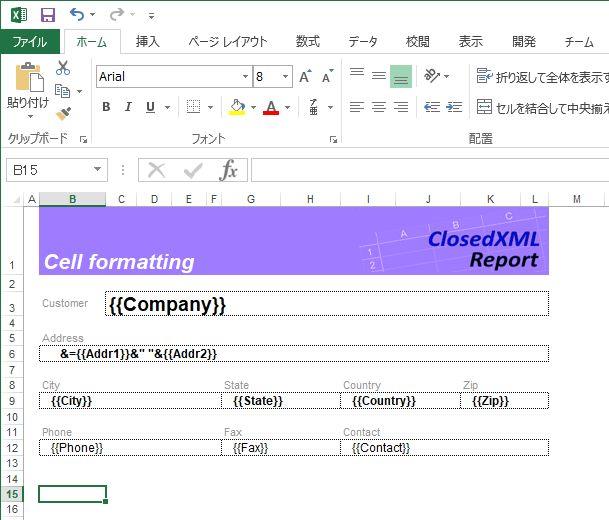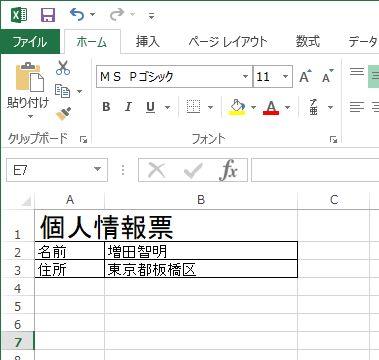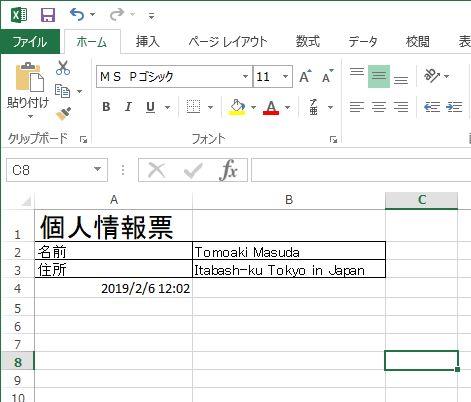MVVMパターンを考えるとき、ViewはXAMLとかGUIだろうという固定観点があるが、実はそうではない。と思うのだがどうだろうか?いわゆる、ASP.NET MVC の View にWeb APIを割り当てると View ってのは XML や JSON になる。クライアントから見れば XMLやJSON はデータだが、MVCパターンで作られたWebアプリにしてみれば、XMLやJSONをViewに見立てることができる。実際、Web APIを作るとき複雑なXMLを返す場合は、Viewの機能を使ったほうが楽だったりする。
ClosedXMLをViewに見立てる
CloseXMLを使って、Excelに値を書き込もうとするとき Cell(row,column)あるはCell(“A1”)を使うわけだけど、ここの書き込み先をXAMLのバインドのように書けないだろうか?ってのを思いついた。
で、ClosedXML.Report https://github.com/ClosedXML/ClosedXML.Report はテンプレート用のExcelを作っておいて、あらかじめ名前を付けておく。
確かに、こんな風に Excel に名前を付けておいて、そこを目指して書き込むのもいいんんだが、なんらかのマークを書いておかなければいけないのが微妙な感じがする。実は、XAML も {Binding propName} という形で XAML 自身に記述するので似たようなことをやっているのだが。
これ、マークを View のほうに書いているけど、じゃあ ViewModel のほうに書くのはどうか?とおもってみたのがこれ。
テンプレートとなるExcelはふつうに記述しておく。
書き込んだ結果はこっち
Excelへの書き込み位置は、ViewModelに属性として記述する。
public class ViewModel : ObservableObject
{
private string _Name, _Address;
private string _ModifiedDate;
[ExcelBinding(Address: "B2", Property: "Value")]
public string Name { get => _Name; set => SetProperty(ref _Name, value, nameof(Name)); }
[ExcelBinding(Address: "B3", Property: "Value")]
public string Address { get => _Address; set => SetProperty(ref _Address, value, nameof(Address)); }
// 更新日時
[ExcelBinding(Address: "A4", Property: "Value")]
public string ModifiedDate { get => _ModifiedDate; set => SetProperty(ref _ModifiedDate, value, nameof(ModifiedDate)); }
}
ViewModelからClosedXMLを通してExcelに書き込むコードはこんな感じ。
ExcelBind _bind;
ViewModel _vm;
public void LoadExcel()
{
string tableName = "Personal";
string path = @"C:\Users\masuda\Documents\サンプルテンプレート.xlsx";
using (var wb = new XLWorkbook(path))
{
var sh = wb.Worksheets.FirstOrDefault(t => t.Name == tableName);
_bind = new ExcelBind(sh);
_vm = new ViewModel();
_bind.DataContext = _vm;
_vm.Name = "Tomoaki Masuda";
_vm.Address = "Itabash-ku Tokyo in Japan";
_vm.ModifiedDate = DateTime.Now.ToString(); // 更新日を表示
wb.SaveAs(@"C:\Users\masuda\Documents\sample_output.xlsx");
}
}
当然のことながら、ClosedXML にはバインディング処理はないので、ClosedXMLのXLWorkbookとIXLWorksheetをラップするような橋渡しのExcelBindクラスを作る。ExcelBindクラスにはMVVMパターンのDataContextプロパティを持っているので、これにバインドする。
ViewModel の各種プロパティに設定をすると INotifyPropertyChanged インタフェースを使って、View に見立てられた ClosedXML に値を書き込むという仕組み。ClosedXML は入力インターフェースを持たないので、ClosedXML からの TextChenge などのイベント受信は不要(実は自動計算などがあるから、無いわけではないのだが)というわけだ。
ViewModel クラスは普通の MVVM パターンと同じようにプロパティに値を設定すればよい。
内部実装
ざっと内部的な実装を
目的のセルを設定するExcelBinding属性
“A1″や行列で指定する。将来的にはセルの名前を設定できるのもよいだろう。
[AttributeUsage(AttributeTargets.Property, AllowMultiple = false, Inherited = false)]
public class ExcelBindingAttribute : Attribute
{
public string SheetName { get; }
public string Address { get; }
public int Row { get; }
public int Column { get; }
public string PropertyName { get; }
public ExcelBindingAttribute(string Sheet, string Address, string Property )
{
this.SheetName = Sheet;
this.Address = Address;
this.PropertyName = Property;
}
public ExcelBindingAttribute(string Sheet, int Row, int Column, string Property )
{
this.SheetName = Sheet;
this.Row = Row;
this.Column = Column;
this.PropertyName = Property;
}
public ExcelBindingAttribute(string Address, string Property = "Value")
{
this.SheetName = "";
this.Address = Address;
this.PropertyName = Property;
}
public ExcelBindingAttribute(int Row, int Column, string Property = "Value")
{
this.SheetName = "";
this.Row = Row;
this.Column = Column;
this.PropertyName = Property;
}
}
橋渡しをする ExcelBind クラス
内部的にClosedXMLのXLWorkbookかIXLWorksheetを持たせる。DataContextプロパティに設定した ViewModel の PropertyChanged イベントをフックして、ClosedXML 経由で目的のセルの値を変更する。プロパティは、簡易のため Value のみに固定している。
GetDataContext メソッドは、逆向きで Excel シートから ViewModel を作るときに使う。
public class ExcelBind
{
private XLWorkbook _workbook;
private IXLWorksheet _worksheet;
public ExcelBind(XLWorkbook book) { _workbook = book; }
public ExcelBind(IXLWorksheet sheet) { _worksheet = sheet; }
private object _DataContext = null;
public object DataContext
{
get => _DataContext;
set
{
if (_DataContext != value)
{
_DataContext = value;
if ( _DataContext is INotifyPropertyChanged )
(_DataContext as INotifyPropertyChanged).PropertyChanged += _DataContext_PropertyChanged;
}
}
}
private void _DataContext_PropertyChanged(object sender, PropertyChangedEventArgs e)
{
if (_DataContext == null) return;
// 1.ViewModelのプロパティ名からリフレクションで値を取得
var pi = _DataContext.GetType().GetProperty(e.PropertyName);
if (pi == null) return;
// 2.属性から設定先のClosedXMLのプロパティを取得
var attr = Attribute.GetCustomAttribute(pi, typeof(ExcelBindingAttribute)) as ExcelBindingAttribute;
// 3.設定先にリフレクションで値を代入
try
{
if (string.IsNullOrEmpty(attr.Address))
{
// Row,Column 指定の場合
if (_worksheet != null)
_worksheet.Cell(attr.Row, attr.Column).Value = pi.GetValue(_DataContext);
if (_workbook != null && _workbook.Worksheet(attr.SheetName) != null)
_workbook.Worksheet(attr.SheetName).Cell(attr.Row, attr.Column).Value = pi.GetValue(_DataContext);
}
else
{
// Address 指定の場合
if (_worksheet != null)
_worksheet.Cell(attr.Address).Value = pi.GetValue(_DataContext);
if (_workbook != null && _workbook.Worksheet(attr.SheetName) != null)
_workbook.Worksheet(attr.SheetName).Cell(attr.Address).Value = pi.GetValue(_DataContext);
}
}
catch { } // 例外は無視する
}
public void SetDataContext(object context) { _DataContext = context ; }
public T GetDataContext<T>( T o = null ) where T : class, new() {
if ( o == null ) o = new T();
// バインド先のデータを workbook/worksheet から取り出す
// 1.プロパティ一覧を取得
var props = o.GetType().GetProperties();
foreach ( var pi in props )
{
// 2.ExcelBindingAttribute属性がついているプロパティを取り出す
var attr = Attribute.GetCustomAttribute(pi, typeof(ExcelBindingAttribute)) as ExcelBindingAttribute;
if ( attr != null )
{
IXLWorksheet sh = _worksheet;
if ( sh == null )
{
if (_workbook != null && _workbook.Worksheet(attr.SheetName) != null)
sh = _workbook.Worksheet(attr.SheetName);
}
if ( sh == null ) { return o; }
// 4.ViewModel のプロパティに値を設定する
if (string.IsNullOrEmpty(attr.Address))
{
pi.SetValue(o, sh.Cell(attr.Row, attr.Column).Value);
}
else
{
pi.SetValue(o, sh.Cell(attr.Address).Value.ToString());
}
}
}
return o;
}
}
逆に Excel シートから ViewModel を構成する
ExcelBindのGetDataContextメソッドを使って、ViewModelを構成する例。これを使うと、Excel シートに記入してもらって、そこから値を取り出すのが楽にできるのでは?と考えたりする。
private void clickGetFromExcel(object sender, RoutedEventArgs e)
{
string tableName = "Personal";
string path = @"C:\Users\masuda\Documents\sample_output.xlsx";
using (var wb = new XLWorkbook(path))
{
var sh = wb.Worksheets.FirstOrDefault(t => t.Name == tableName);
_bind = new ExcelBind(sh);
// ViewModel を再構成
var vm = _bind.GetDataContext<ViewModel>();
System.Diagnostics.Debug.WriteLine(vm.Name);
System.Diagnostics.Debug.WriteLine(vm.Address);
System.Diagnostics.Debug.WriteLine(vm.ModifiedDate);
MessageBox.Show(vm.Name);
}
}
ViewModelからPropertyChangedを受ければViewになるのか?
直接 ClosedXMLに渡すわけではないが、ExcelBindクラスを媒介して値のやり取りができている。WPFやUWPのようなユーザーインタフェースはないが、ViewModelクラスのプロパティを使ってView(この場合はExcelシート)にアクセスできている。
この部分、構造が簡単な XML ならばデータとして扱うのだが、ExcelのOpenXML形式のように複雑怪奇なXMLの場合、ピンポイントで修正することを考えると「View」として扱うのがベターではないかと思っている。
ViewModelのプロパティは、別途DIなどでXMLやJSONから読み込むようにすれば、消えてしまった InfoPath のようにできるのではないな、と。
このあたりを少し整理して、NuGet に挙げられるようにする予定。





